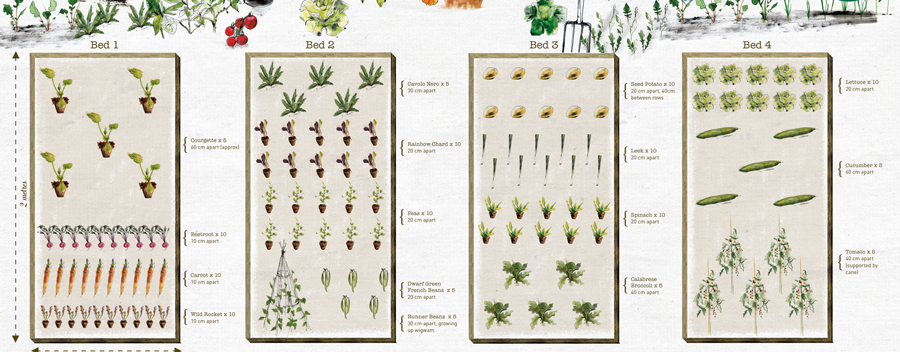With the weather so chilly you may not be feeling very motivated to get out into the garden. You can still make some progress though by planning how to lay out all your crops this year. This little guide will help you get started.
1. There’s no right or wrong:
We have seen very successful veg plots where sweetcorn, squashes, artichokes, broad beans, carrots, herbs and tomatoes are all crammed in to a single bed at random to grow freely (with grass and dandelions packed in tightly too). There really is no right or wrong so don’t fret over it all too much. The idea with planning is to make it nice and easy for yourself when it comes to planting time, to make it a little easier for you to care for your plants, and to make sure your crops have a good chance to flourish.
2. Grouping plants:
As a general rule it is easiest to group plant types together in beds as this allows you to care for them in a similar way. For example, brassicas will benefit from netting, root vegetables will need nice loose soil, peas and beans will need more frequent watering than carrots and parsnips and so on.
To keep it really simple, we would recommend having a separate bed (or zone within a bed) for the following plant groups:
Potatoes & Roots – parsnips, carrots, beetroot, celeriac (turnips/swede could go here too)
Brassicas – cabbages, kales, cauliflower, broccoli (turnips/swede are technically brassicas but you may prefer to keep them with the roots)
Onions & Leeks – leeks, spring onions, onions, garlic (it’s easier to keep on top of weeds if they are in their own little area)
Then you can be a bit more relaxed over where you plant other things like salads and lettuces, beans and peas which can easily mingle together or be popped between other rows of veg.
3. Put taller veg at the back:
This is an easy one – bear in mind where the sun will be and put shorter plants at the front, closer to the sun, and taller plants at the back. This will allow the sunshine to reach all your crops and promote better growth. These are the tallest:
- Climbing beans
- Sweetcorn
- Tomatoes
- Jerusalem Artichokes
- Globe Artichokes
4. Give plants space – If planting in beds, try to give your plants the root space that they need (we’ve got a helpful guide to plant spacing coming soon so keep an eye out) as this will really help them to defend themselves against pests and disease as well as giving them access to water, nutrients and sunlight. If growing in pots, you can usually plant a little closer together as long as you water regularly and remember to add a liquid feed from time to time.
Remember, that if you need to leave 40cm between rows of brassicas, you can still put a row of, say, lettuce in between them.
5. Sketch it out – this is probably the easiest way to plan…simply sketch out your beds and mark where you plan to plant each vegetable type. For inspiration, have a look at this Small Veg Patch example
(Please note, if you’ve ordered one of our Veg Patches, you’ll receive a garden layout plan by email in April.)

